When to harvest leeks and how to store them
Leek or Pearl onion is a biennial plant rich in vitamins and nutrients, with a milder taste than regular onions. It can be eaten raw, fried, marinated, stewed and boiled.
To consume this vegetable all year round, it is enough to know the rules for its cleaning and storage. After all, the leek collected at the right time under the right conditions will retain its taste and useful properties until the next harvest.
The content of the article
Optimal cleaning times
The timing of harvesting onions depends primarily on the growing region and varieties.
In the middle lane preparation for planting in the soil begins in January. Leeks are sown in boxes, illuminated with a lamp, ventilated, and in February they dive. In mid-April, they are planted in open ground. With this approach, the crop is harvested in August-September.
In the northern and northwestern regions use only early varieties and hybrids, for example, Vesta, Columbus, Elephant trunk. Seedlings are planted in a permanent place in mid to late May. The harvest ripens in the second or third decade of September.
In the southern regions seeds are planted directly into the ground at the end of April - beginning of May. Sometimes an unheated greenhouse is used to solve the problem of excessive rainfall (in highly moist soil, the bulb can rot). The leek reaches maturity in early August.
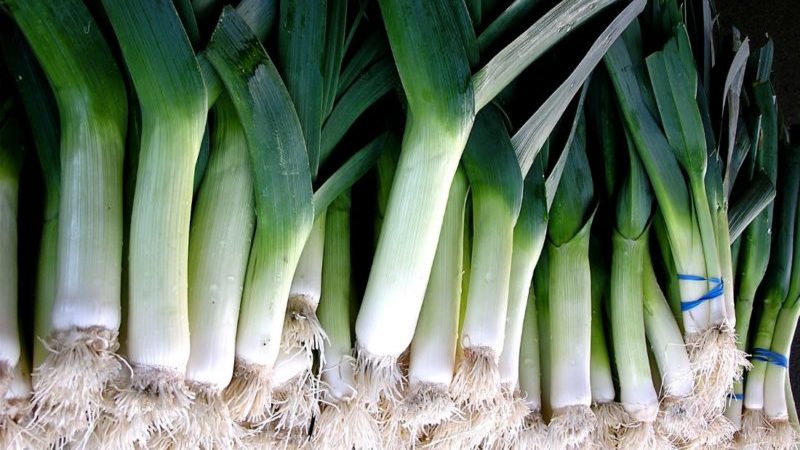
Depending on the timing of ripening, the varieties are divided into:
- early;
- mid-season;
- late ripening.
The early ripening period is 90-130 days. The harvest of these varieties is harvested in August-September. The early leek is ideal for summer consumption. Early varieties include:
- Elephant's trunk. The leg of the onion is dense and fleshy, reaching 30 cm. To achieve this indicator, the onion needs to be twisted. This procedure is also called "whitening". To make the leg white and juicy, the leaves are twisted, as a result, the stem does not have time to turn green.
- Columbus. Dutch variety. The main difference is that due to low growth, the stems can not be twisted. Reaches a height of 70-80 cm, and the leg is up to 20 cm and about 6 cm in diameter.
- Vesta. Bred by Russian specialists. Differs in soft, sweetish taste. It grows up to 1.5 m in height, with a stem up to 30 cm. This variety is grown mainly through seedlings, especially in temperate regions. The crop is harvested 120 days after sowing.
Mid-season varieties:
- Casimir. Unlike other varieties, its leaves are almost vertical. Does not tolerate excess moisture and prefers the seedling method of growing.
- Winner. This variety is popular in the northern regions as it is frost-resistant. The leaves are green, with a bluish bloom, which gives the plant a gray tint.
- Elephant. Reaches 1.5 m and has a large stem in diameter - 5-7 cm. This type of onion requires twisting. Seedling propagation is preferred. Ready to harvest 130 days after disembarkation.
Late-ripening varieties, like mid-ripening ones, are frost-hardy, but in cold regions, for example, in the Urals or Western Siberia, they do not have time to ripen. After all, such a leek needs from 180 to 200 days. Popular varieties:
- Alligator. Its distinctive feature is its delicate taste and light garlic aroma.
- Karantansky. Ripening occurs 200 days after sowing, while leeks reach 1 m in height. Planted in early spring as seedlings.
- Bandit. Another native of Holland with dark green leaves and a slight blue tint.In the middle lane tolerates wintering well.
- Autumn giant. Impressive in size: the leg reaches a length of 40-50 cm, and in diameter - 8-9 cm. It is well stored.
Some late-ripening varieties are left to winter in the garden. With this method, the main thing is to spud the stem of the stem higher and insulate it with spruce branches and peat. Then the vegetable will easily endure the mild winter under a thick layer of snow and the harvest can be harvested in May-June.
The harvest time will be prompted by the lunar calendar. Celestial bodies affect all living things, including plants. Some days when the moon comes closer to earth, moisture is better attracted to plant roots. This time is considered the most suitable for harvesting.
Auspicious days for harvesting in 2020 according to the lunar calendar:
- August: full moon on August 3, waning moon from August 4 to 18;
- September: full moon on September 2, waning moon from September 3 to 16;
- October: full moon on October 3, waning moon from October 3 to 15.
Following the advice of the calendar, you need to harvest at the beginning of the month. The moon is in the waning phase, and this is a favorable condition for drying and storage of crops. It is advisable to harvest on a full moon. During this period, all biological processes in the terrestrial part of plants slow down. Therefore, onions harvested during the full moon period have a high concentration of vitamins and nutrients.
Signs that the crop is ready for harvest
Knowing the exact date of planting and the growing season, you can calculate the ripening time of the crop.
However, a ripe leek can also be identified by external signs:
- dry feather lying on the ground;
- dry neck that does not release moisture when pressed;
- dense, dry-scaled bulb.
These signs indicate that it is time to harvest the vegetable. In addition, a mature leek has a thin, yellowish neck. Lying feathers also turn yellow. However, if the season was rainy, this feature will not show up.
How to collect onions from the garden for storage
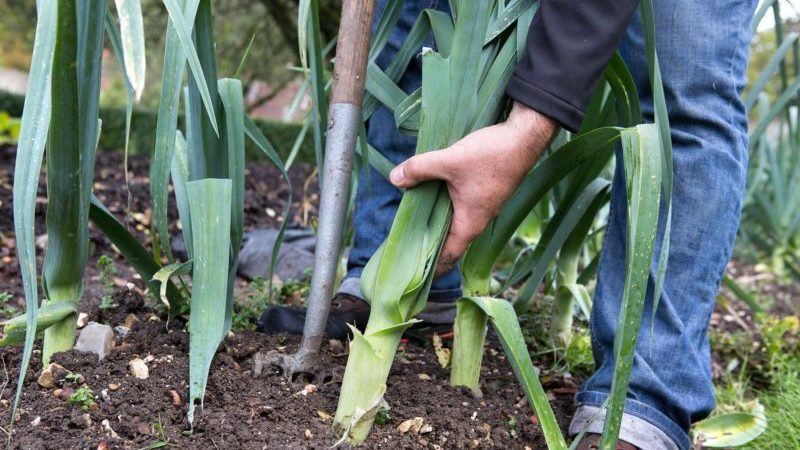
Onions are harvested only in sunny weather. If the rains drag on, and the time to harvest has come, bend the feathers a little to the ground - they will stop feeding and begin to dry out faster.
You should not trim leek feathers - this is its main value. In addition, this method will not accelerate the ripening of the onion, but infect the plant. Bacteria and microorganisms can cause rotting when the feather is trimmed.
Important. To protect the onion from damage, do not scoop it up with a shovel.
It is easy to pull the vegetable out of loose soil with your hands. In dense ground, arm yourself with a pitchfork.
Do not extend the harvest for too long. Allow no more than 10 days for this. The plants harvested last will be more moist, causing the entire batch to rot.
The stems are carefully cleaned from the ground. Do not hit the bow on the ground or other object - damaged heads are prone to decay. Better to remove the extra excess land by hand.
After harvesting, the onions are dried - this will take about two weeks. To do this, it is left in the garden bed, evenly spread out on polyethylene, previously covered with a cloth. This will help protect your crop from pests.
Attention. If it is about to rain, move the bow indoors. This will increase the term drying for about a week.
Before removing the leek for storage, it is carefully examined and sorted out. Rotten, damaged bulbs are discarded so as not to spoil the whole batch.
Storage features
You can store onions in various ways.
Preservation and salting
Harvesting leeks for the winter in marinade is no different from cooking other vegetables. Wine and table vinegar, lemon juice, and sugar act as preservatives.
The algorithm is as follows:
- Take 5-6 stems (only the white part), 1 tsp. salt, 1 tbsp. l. sugar, 2 tsp. lemon juice, 1 tbsp. l. 9% vinegar, 5-6 allspice peas and 2-3 bay leaves.
- The leg is cut into rings 0.5 cm thick, placed in a jar.
- 0.5 l of water is brought to a boil, salt, sugar, vinegar, pepper, lemon juice and bay leaf are poured.
- After letting the marinade boil for 5 minutes, pour the onion and close the jar.
You can also pickle onions. To do this, it is thoroughly mixed with salt (1 tbsp. L salt per 200 g of leek cut into rings) and tightly placed in sterilized jars. It is advisable to take small jars with screw caps. It is better not to store open containers, but to use the contents immediately.
Storage in a cellar or basement
This method implies several recommendations:
- Trim the roots.
- Shorten the tops by a third.
- Place the onions vertically in dry, well-ventilated containers. Empty plastic bottles with the top cut off will do. For ventilation in the bottles, several holes are made at the level of the white part of the stem.
Air humidity in the room should not be more than 65%. A hygrometer is used for control.
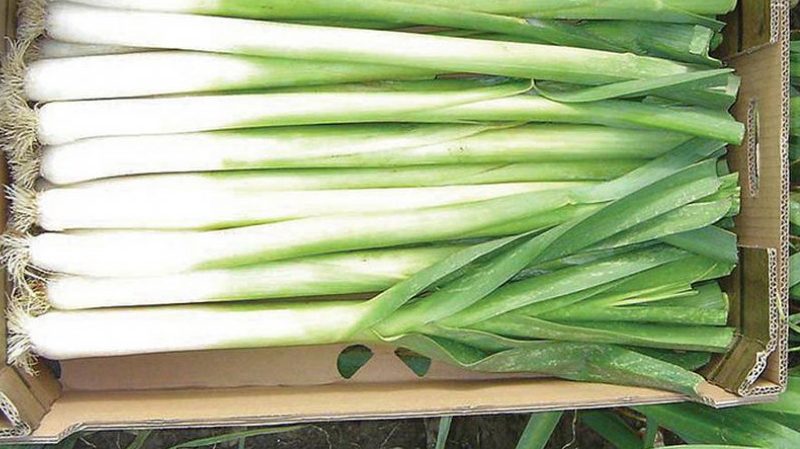
Storage in the beds
Part of the crop is left in the beds for consumption in early spring. Before the cold snap, at the end of October, the leek is once again huddled, covered with fallen leaves or spruce branches, and when it snows, the plants are sprinkled on top of them. In the spring, after thawing, dig out the required amount.
Reference. Since leek is a two-year-old plant, several bushes can be left in the garden for their own planting material. Remember that hybrids are not suitable for this operation.
Freezing and storing in the refrigerator
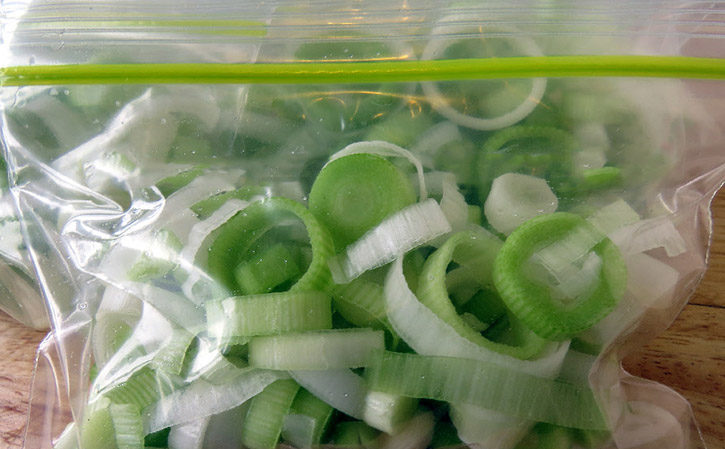
Since at freeze leek does not lose vitamins and structure, it can be stored in the freezer. To do this, remove the green leaves, wash and dry your foot. Cut it into rings and place in a plastic bag or tray.
Important. You can store pearl onions just in the refrigerator without freezing. The product will retain its beneficial properties for six months. The container or bag of onions must have ventilation openings.
Drying
With this method, the stem is cut into rings with a thickness of 1-2 cm, and placed in the dryer for 5 hours. Air temperature - no more than + 40 ° С, otherwise vitamins will not be saved. You can keep the dried product in glass jars under a lid.
If you don't have a dryer, you can use an oven. At a temperature of 40-50 ° C, the stems cut into rings are dried for 2-3 hours.
In sand
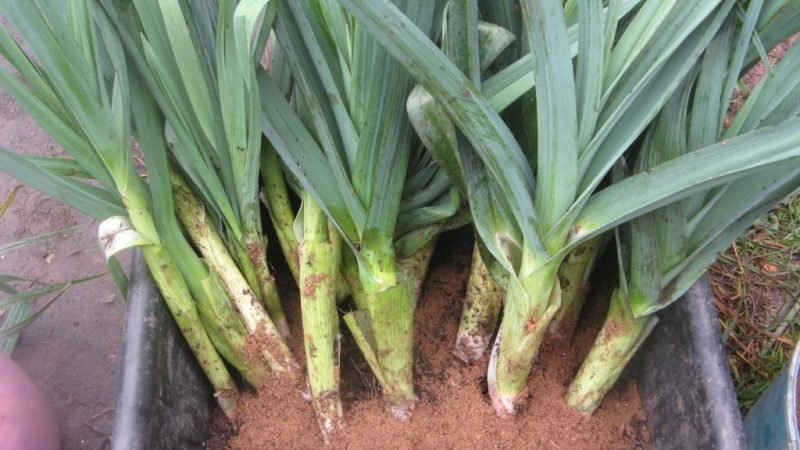
The stems keep well when placed vertically in a container of sand. In this case, it is better to anneal the sand. This will save the onion from parasites.
On the balcony
When stored on a balcony, the container is wrapped in a blanket or heat-insulating material (mineral wool) in order to avoid complete freezing during severe frosts.
Conclusion
Growing leek at home does not require serious investment or hard work. It is enough to choose a variety that suits the climatic conditions, purchase seeds, soil and a container for seedlings.
Compliance with the rules of cleaning and storage will help to have aromatic dishes with pearl onions on the table all winter. And the ability of leeks to retain vitamins long after harvest makes it an indispensable product in the cold season.